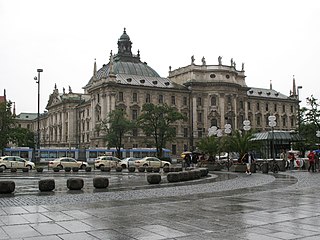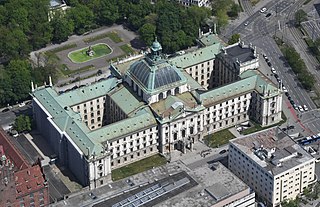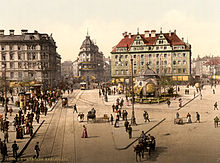
Charles Theodore was a German nobleman of the Sulzbach branch of the House of Wittelsbach. He became Count Palatine of Sulzbach from his father Johann Christian in 1733, at the age of six. With the death of his cousin, Charles III Philip, he became Prince-elector and Count Palatine of the Rhine in 1742, being eighteen. In his fifties, he became Prince-Elector of Bavaria at the death of another cousin, Maximilian III Joseph, in 1777.

Friedrich David Gilly was a German architect and the son of the architect David Gilly. His works are influenced by revolutionary architecture (Revolutionsarchitektur). Born in Altdamm, Pomerania,, Gilly was known as a prodigy and the teacher of the young Karl Friedrich Schinkel.

Stachus is a large square in central Munich, Bavaria. The square was officially named Karlsplatz in 1797 after the unpopular Charles Theodore, Elector of Bavaria. Munich natives seldom use that name, calling the square instead Stachus, after the pub Beim Stachus, once owned by Eustachius Föderl, that was located there until construction work for Karlsplatz began. Even the U-Bahn and S-Bahn announcements use the unofficial name.

München Hauptbahnhof or Munich Central Station is the main railway station in the city of Munich, Germany. It is one of the three stations with long-distance services in Munich, the others being Munich East station and Munich-Pasing station (München-Pasing). München Hauptbahnhof sees about 450,000 passengers a day, which puts it on par with other large stations in Germany, such as Hamburg Hauptbahnhof and Frankfurt (Main) Hauptbahnhof. It is classified by Deutsche Bahn as a category 1 station, one of 21 in Germany and two in Munich, the other being München Ost. The mainline station is a terminal station with 32 platforms. The subterranean S-Bahn with 2 platforms and U-Bahn stations with 6 platforms are through stations.

The Nymphenburg Porcelain Manufactory is located at the Nördliches Schloßrondell in one of the Cavalier Houses in front of the Nymphenburg Palace in Munich, Germany, and since its establishment in 1747 has produced porcelain of high quality. It is one of the last porcelain producers in the world where every single part is made entirely by hand.

The Brown House was the name given to the Munich mansion located between the Karolinenplatz and Königsplatz, known before as the Palais Barlow, which was purchased in 1930 for the Nazis. They converted the structure into the headquarters of the National Socialist German Workers' Party. Its name comes from early Nazi Party uniforms, which were brown. Many leading Nazis, including Adolf Hitler, maintained offices there throughout the party's existence. It was destroyed by Allied bombing raids during World War II.

Sigmaringen Castle was the princely castle and seat of government for the Princes of Hohenzollern-Sigmaringen. Situated in the Swabian Alb region of Baden-Württemberg, Germany, this castle dominates the skyline of the town of Sigmaringen. The castle was rebuilt following a fire in 1893, and only the towers of the earlier medieval fortress remain. Schloss Sigmaringen was a family estate of the Swabian Hohenzollern family, a cadet branch of the Hohenzollern family, from which the German Emperors and kings of Prussia came. During the closing months of World War II, Schloss Sigmaringen was briefly the seat of the Vichy French Government after France was liberated by the Allies. The castle and museums may be visited throughout the year, but only on guided tours. It is still owned by the Hohenzollern-Sigmaringen family, although they no longer reside there.

The neoclassical Brienner Straße in Munich is one of four royal avenues next to the Ludwigstraße, the Maximilianstraße and the Prinzregentenstraße. The boulevard was constructed from 1812 onwards, during the reigns of Maximilian I Joseph of Bavaria and his successor Ludwig I, in accordance with a plan by Karl von Fischer and Friedrich Ludwig von Sckell. The avenue is named after the Battle of Brienne.

The Maximilianstraße in Munich is one of the city's four royal avenues next to the Brienner Straße, the Ludwigstraße and the Prinzregentenstraße. It starts at Max-Joseph-Platz, where the Residenz and the National Theatre are situated, and runs east-west. Planned and begun in 1850 by King Maximilian II of Bavaria, the street takes his name. The lead architect was Friedrich Bürklein. Today, Maximilianstraße has the distinction of the highest retail rents in Germany.

The Justizpalast Munich are two courthouses and administrative buildings in Munich.

The Isartor at the Isartorplatz in Munich is one of four main gates of the medieval city wall. It served as a fortification for the defence and is the most easterly of Munich's three remaining gothic town gates. The gate is located close to the Isar and was named after the river.

The Botanischer Garten München-Nymphenburg is a botanical garden and arboretum in Munich, Germany.

Geisel Privathotels is a privately owned hospitality group founded in 1900 operating three hotels and a restaurant in Munich, Germany.

The Old Botanical Garden is an urban park and former botanical garden in Maxvorstadt, Munich, Germany.

The Alter Nordfriedhof is a former cemetery located in the Arcisstrasse in Maxvorstadt, Munich, Bavaria, Germany. It is not to be confused with the Nordfriedhof in Munich, which was set up only a short time later in Schwabing. Construction began in 1866 to designs by the city architect Arnold Zenetti.

The Ostfriedhof is a cemetery in Munich, situated in the district of Obergiesing, established in 1821 and still in use. It contains an area of more than 30 hectares and approximately 34,700 burial plots.

Sep Ruf was a German architect and designer strongly associated with the Bauhaus group. He was one of the representatives of modern architecture in Germany after World War II. His elegant buildings received high credits in Germany and Europe and his German pavilion of the Expo 58 in Brussels, built together with Egon Eiermann, achieved worldwide recognition. He attended the Interbau 1957 in Berlin-Hansaviertel and was one of the three architects who had the top secret order to create the governmental buildings in the new capital city of the Federal Republic of Germany, Bonn. His best known building was the residence for the Federal Chancellor of the Federal Republic of Germany, built for Ludwig Erhard, the so-called Chancellor's Bungalow.

The Georgenstraße is a street in Munich, Germany and runs in an east-west direction north of the city center. It separates the Maxvorstadt in the south from Schwabing in the north. It leads from Leopoldstraße in the east to Lothstraße in the west. In the street, especially at the beginning are several magnificent buildings, in the western direction are simple rental units. The Georgenstraße has little traffic significance and it is quiet despite its relative proximity to the city center; apartments, small shops, cafes and other small businesses are found there.

Friedrich Maximilian Thiersch, after 1897 Ritter von Thiersch, was a German architect and painter in the late Historicist style.




















